SXSW 2018 Film Recap: Looking Good at 25!
Written by: Christopher Llewellyn Reed | March 23rd, 2018

South by Southwest (SXSW), a multimedia festival showcasing music, film and interactive technology and design, was founded in 1987, devoted at first solely to music. Then, in 1994, the film and interactive conferences were added. 2018 marked the 25th iteration of these last two, which run concurrently, though interactive stops midway through the second week, making room for music, which closes out the festival; film runs the entire time. Since 2013, there has been an additional gaming expo, which also starts in the second week. This year, SXSW ran March 9-18, and there was quite a lot happening – just on the film side, alone – from screenings to keynote speakers to panels to meetups, and more, not counting the many “convergence” events that brought attendees from the multiple conferences together to celebrate what they have in common. In addition, for the second year in a row, SXSW presented works of virtual cinema (VR and AR) in one big exhibition space, expanding the festival’s reach to include today’s cutting-edge storytelling platforms.
This was my 5th year in attendance, and I saw quite a few good films, as well as some quality VR. I didn’t see that much that I didn’t like, in fact, so it is easy to focus on the positive. As it does every year, the festival awards both jury prizes and audience awards, a few of which coincide with my own top choices, and others of which I, sadly, missed (such as Jinn, which I really wanted to see). As I did last last year, I present a list, below, of my personal favorites, complete with capsule reviews, ranked within separate categories. But whereas last year I broke “mainstream” (bigger budget/blockbuster material) fictions films apart from their “specialty” (indie and smaller budget) cousins, this year I really only saw one film that I would consider big enough to put into that category: Steven Spielberg’s Ready Player One (which, dear reader, I loved). So, I start with that, then give an overview of the works of virtual cinema I was lucky enough to watch, and then present my Top 5 in both fiction and documentary areas. Where I have previously written a full review for Hammer to Nail, the online magazine where I am lead film critic, I indicate such fact within the body of the text. Enjoy!
BLOCKBUSTER EXTRAVAGANZA

Ready Player One (Steven Spielberg, 2018)
Adapted from Ernest Cline’s 2011 debut sci-fi novel of the same name, Steven Spielberg’s Ready Player One – his 31st theatrical feature – delivers on the promise of the book, despite lackluster trailers that had me concerned. I loved the source text, and I loved the movie. Set approximately 25 years from now, both tell the story of Wade Watts, a poor kid who lives in “the stacks,” a slum of what look like cargo containers stacked the one on top of the other. Like most of the rest of humanity on a planet plagued by environmental and financial crises, he escapes, daily, into the “OASIS,” a virtual-reality world that combines the best/worst features of Amazon, Google and a Sony PlayStation (or any other advanced game system).
When the inventor of said OASIS – James Halliday – dies, he leaves behind a hidden quest, with clear instructions that whoever should triumph will rule his company. Naturally, the competition is fierce, but Wade and his online friends have a deep advantage: they have spent years studying the 1980s culture that was Halliday’s own obsession. Perhaps, just this time, the meek shall inherit the earth. Of course, if you’ve seen any other Spielberg film, you’ll know that they usually do, in his universe.

With a cast that includes Tye Sheridan (Detour), Olivia Cooke (Katie Says Goodbye), Lena Waithe (showrunner of Showtime’s The Chi), Mark Rylance (Bridge of Spies) and Ben Mendelsohn (Darkest Hour), among others, the film showcases as much fine acting as cutting-edge CGI. Filled with intense action scenes leavened by humorous interludes, it’s an entertaining ride from start to finish. Despite how good it is, perhaps my favorite moment at the premiere screening on Sunday night, March 11, was when the sound system went out at the start of the big climactic battle. We all thought the sudden silence was intentional, but when we realized it wasn’t, we just started making up our own sound design. We were that into it. So, too, will be you. Get ready.
VIRTUAL CINEMA and ART
I saw one interactive web documentary (presented as an art installation), and two actual VR movies, all interesting, all worth mentioning. In the order in which I visited them on Thursday, March 15, they were …

Life Underground (Hervé Cohen)
A mesmerizing collection of short films shot in the subways of 14 different subway cities around the world, Life Underground, launched during this year’s SXSW, from documentary filmmaker Hervé Cohen consists, in its current form, of approximately two hours of footage spread out across an interactive web interface (which I saw as part of a multi-panel exhibit created in collaboration with installation artist Tonian Irving). Users can click on different cities, on an introductory map, to switch directly from Los Angeles to Montreal to Santiago (Chile) to Madrid to Vienna to Hong Kong to Tokyo and more. Perhaps most delightfully, one can create one’s own itinerary at the start, or jump randomly within the experience.

Beyond the presentations of the various environments, Cohen includes a variety of interviews with people on the trains, which one accesses by clicking on the names that pop up on-screen at certain points. Each interview is approximately 2½ to 3 minutes long, just enough time to provide a glimpse into a stranger’s life. Normally, we tend to ignore our fellow passengers on our quotidian travels to and from work; or, if we don’t ignore them, we avoid talking to them, even as we observe from a distance. Cohen breaks down that barrier, revealing the human beings behind the hard masks of the daily commuter. “Beneath the surface, we’re all connected,” reads the opening tagline. Indeed, we are.
I loved this piece. And it’s only going to get better. For now – though he has shot more (15 per city) – Cohen includes 3 passenger interviews per city, in 13 of the 14 cities in which he filmed. As he explained to me, the only thing stopping him from expanding is budget, since all interviews need to be translated into all the languages represented within the totality of the project. But eventually, Life Underground could be even more comprehensive that it is now. I can’t wait. Be forewarned, however, as the movie is addictive, and even at only two hours, can suck you in completely. Now that’s immersion!
Greenland Melting (Raney Aronson-Rath/Julia Cort/Nonny de la Peña/Catherine Upin)
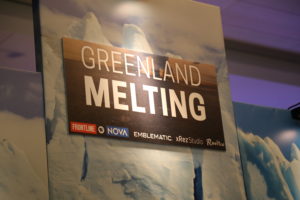
Described in its press materials as “a walk-around virtual reality film,” Greenland Melting (a collaboration between Emblematic Group, PBS FRONTLINE and NOVA), which had its North American premiere at SXSW, provides a brief (a little over 12 minutes) look at the dire state of Greenland’s rapidly melting glaciers. The viewer gets to stand on the edge of an ice shelf, soar about the retreating ice floes in a helicopter, and even dip below the surface of the freezing ocean to look at the glacier from a low, watery angle. The visuals are all solid – I particularly liked the vertiginous feel of my lean through the helicopter door (as per the recommendation of the filmmakers) – and the interactive interface requires little prior VR experience. Based on this movie, alone, one can see the utility of the VR medium in offering comprehensive, immersive engagement with potentially overwhelming subjects. Greenland may be melting, yes, but at least we get this fine work of cutting-edge art out of it.
SPHERES: Songs of Spacetime (Eliza McNitt)

This eerie journey into the center of a black hole, with accompanying score by Kyle Dixon and Michael Stein of S U R V I V E , and voiceover narration by Jessica Chastain, offers a short (also about 12 minutes), but engaging glimpse at the inner workings of our universe. The haptic controllers allow the viewer to reach out and touch the stars in a manner that one-ups (and then some) any planetarium experience one has ever had. I also loved how the film ends with a graphic interaction with one’s voice, transforming the sounds we make into waves of color. The “song” of the subtitle, therefore, is as much our own as the filmmaker’s. It’s a beautiful use of the interactive possibilities of the medium.
FICTION (or NARRATIVE) (in alphabetical order):
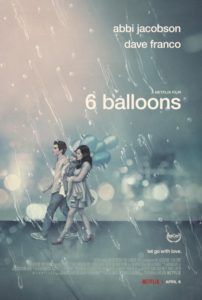
6 Balloons (Marja-Lewis Ryan, 2018) [the paragraph, below, is an adaptation of a longer review I wrote for Hammer to Nail]
A gripping sibling drama featuring a mesmerizing lead performance from Abbi Jacobson (Person to Person), 6 Balloons carries us to a very dark place before bursting in a beautiful final catharsis of relief and release. Despite the air metaphor implied by the title, the movie is filled, instead, with a leitmotif of water, both in image and sound, as Jacobson’s Katie struggles to manage the growing crisis brought on by her brother Seth’s heroin relapse. She is drowning under the weight of his codependent flow of need. She has always been there for him; perhaps it is time to let him solve his own problems, and focus on Katie, instead. In just over 70 minutes of riveting cinema, 6 Balloons ponders whether the greatest act of love Katie could perform for Seth (Dave Franco, The Little Hours) might be to stop fixing every disaster he causes. Beyond the performances and the writing, I love the way 6 Balloons is shot and edited. Ryan frames Katie’s eyes in anxious close-ups from oblique angles, and plays with temporal shifts at important beats in the film that emphasize her characters’ disorientation. No screen time is wasted, no composition not carefully considered. This is real life, in all its harsh glory, and a great filmic achievement.
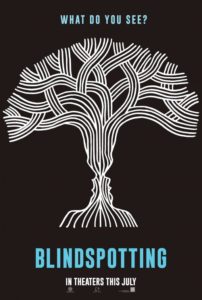
Blindspotting (Carlos López Estrada, 2018) [the paragraph, below, is an adaptation of a longer review I wrote for Hammer to Nail, which has yet to post, as of this writing]
The debut feature from Carlos López Estrada, Blindspotting is written by its two stars – cinematic newcomer Rafael Casal (a veteran performer and founder of the #BARS project at New York’s Public Theater) and theater/TV star Daveed Diggs (Hamilton) –and set in Oakland, California, from which both men hail. It’s a raw, personal story that combines biting humor and stark violence to showcase the sharp racial and class inequalities in many or our country’s urban centers. The movie opens with Collin (Diggs) at the end of a jail sentence, sentenced to a year’s probation in a halfway house, then flashes quickly forward to the final three days of that probation. He works for a moving company run by ex-girlfriend Val (Janina Gavankar), spending his days on the job doing pickups with best friend Miles (Casal). Blindspotting (the term means the inability to see what is right in front of you and comes from a psychology lesson Val studies in her own quest for betterment) follows Collin and Miles as they struggle to define themselves in a universe that already has them pegged as losers. Their comic misadventures, often buoyant and a delight to behold, are always one step away from tragedy. The powerful performances provide ample support to the twisting narrative, and by the cathartic conclusion, we are hooked. With director López Estrada’s additional fine flourishes of mise-en-scène, the movie becomes a magnificent meditation on the state of the nation, and a profoundly rewarding viewing experience.

The Breaker Upperers (Jackie van Beek/Madeleine Sami, 2018) [the paragraph, below, is an adaptation of a longer review I wrote for Hammer to Nail, which has yet to post, as of this writing]
From down under comes a raucous comedy written and directed by, and starring, two of the funniest women I had never heard of before. In their native New Zealand, Jackie van Beek (New Zealand TV3’s Funny Girls) and Madeleine Sami (TV3’s Super City) are known quantities, but here in the United States, much less so, unless one is a fan of Jemaine Clement and Taika Waititi’s 2015 vampire mockumentary What We Do in the Shadows, in which both actresses play small roles. Van Beek and Sami play Jen and Mel, respectively, two longtime friends whose two-person company breaks up couples in which one partner really wants out, but can’t seem to make it happen on his/her own. We meet them in medias res, dressed as cops, as they explain the sudden “vanishing” of one such client to his bereft wife. Her plaintive wails form the background noise of a scene in which truly nasty business is served up as first-class farce. The sparkling promise of this opening – and the delightful montage of similar scenes that immediately follows – is hardly ever broken. Be forewarned: the film may cause as much pain as joy, since the full-body, howling hysterics come at a cost. I recovered, though, and so will you, and it will all have been worth it, for The Breaker Upperers is a must-see cinematic treasure.
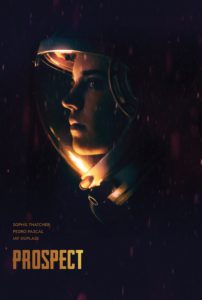
Prospect (Chris Caldwell/Zeek Earl, 2018) [the paragraph, below, is an adaptation of a longer review I wrote for Hammer to Nail, which has yet to post, as of this writing]
Making their feature debut with Prospect, filmmakers Chris Caldwell and Zeek Earl have taken their beautiful, mesmerizing and eerie 2014 sci-fi short of the same name and turned it into an even more compelling work of art that is unlike any other low-budget space-travel film you have ever seen. Starring newcomer Sophie Thatcher and veteran indie and TV actors Jay Duplass (Landline) and Pedro Pascal (Javier Peña on Netflix’s Narcos), with additional cameos from Anwan Glover (Desiree), Andre Royo (Hunter Gatherer) and Sheila Vand (A Girl Walks Home Alone at Night), the movie follows a desperate group of miners on a distant planet, gathering an amber-like material called “aurelac” that fetches huge prices on the intergalactic market. With its exteriors shot in the haunting Hoh Rainforest of Washington State’s Olympic Peninsula (the filmmakers are from Seattle), the movie makes a virtue of limited resources, its low-end aesthetic contributing to the rawness of its survival narrative. Prospect is no fool’s gold, but the real stuff that dreams are made of.

Write When You Get Work (Stacy Cochran, 2018) [the paragraph, below, is an adaptation of a longer review I wrote for Hammer to Nail]
Director Stacy Cochran is back. After an 18-year hiatus (her last feature, Drop Back Ten, came out in 2000), she appears to have lost none of her filmmaking skills, crafting a delightful oddball of a glossy confidence game as engaging as it is unpredictable. With the effortlessly appealing Rachel Keller (Syd on FX’s Legion) and Finn Wittrock (The Submarine Kid) in the lead roles, the movie benefits from solid supporting work from the likes of Emily Mortimer (Mackenzie on HBO’s The Newsroom), Scott Cohen (Jack of the Red Hearts) and Tess Frazer (Callie on Netflix’s Godless), among others. But really, the film’s genuine star is Cochran, who takes us on an entertaining romp through cinematic adventures (and misadventures) that all, somehow, come out just right. Ruth and Jonny (Keller and Wittrock), meet and fall in love in high school. Flash-forward 9 years, and their lives have drifted apart, hers for the better, his for the worse. But when they see each other at the funeral of a shared acquaintance, Jonny makes it his mission to thereafter remind Ruth of her roots, for better or for worse. It’s beautiful storytelling, and a refreshing break from the crushing sameness of so many blockbusters of our era. It’s clear that Cochran’s natural vocation is very much behind the camera, and her new film marks a most excellent return for the prodigal filmmaker. Welcome home.
That’s it for my favorites among the specialty releases, although I’d also like to mention All Square, Don’t Leave Home, Eighth Grade, First Reformed, Pet Names, Sadie and Thunder Road
DOCUMENTARY (in alphabetical order):
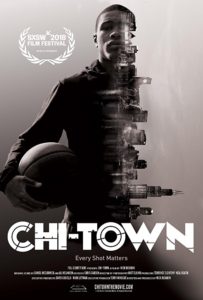
Chi-Town (Nick Budabin, 2018) [the paragraph, below, is an adaptation of a longer review I wrote for Hammer to Nail]
It’s impossible to watch the new documentary Chi-Town, from first-time feature-director Nick Budabin, without thinking of Steve James‘ great 1994 Hoop Dreams (also a first feature). Both movies focus on high-school basketball players from disadvantaged neighborhoods in Chicago, following the up-and-down trajectories of their hopes and, yes, dreams. Whereas James chose multiple subjects and traced their high-school careers, however, Budabin aims his lens squarely on his lone protagonist’s college life and attempted entry into the pros. Keifer Sykes is our guy, 17 years old when the film begins. Recruited by the University of Wisconsin-Green Bay, he knows he’ll miss his family – his mother, father, and young cousins – but perhaps not his native Chicago, riddled by violent crime. The middle section of the documentary, despite some setbacks for Keifer, contrasts his own, positive journey with the more tragic one of those left behind. Friends are shot or arrested, lives shattered. Budabin should be praised for his masterful assembly of over four years’ worth of footage into a solid, coherent narrative. By the end, we feel fully immersed in Keifer’s world and thoughts, engaged in the many challenges he faces. Given the talent on display, we can only hope that both director and subject have many good years ahead of them.
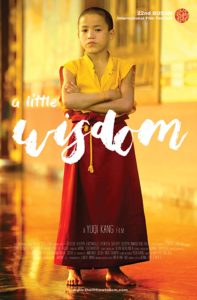
A Little Wisdom (Yuqi Kang, 2017) [the paragraph, below, is an adaptation of a longer review I wrote for Hammer to Nail]
In A Little Wisdom, boys play in fields, chase each other, climb trees, their cries and laughter ringing through the tall grasses and high branches, filled with joyful exuberance, happy in an apparent idyll of tranquil childhood. Though they are like any other boys their age, they are simultaneously something quite different: monks-in-training, deposited at one of 40 monasteries in Lumbini, Nepal (birthplace of the Buddha), near the Indian border. Some are orphans, while others have been left by families who can no longer care for them. Here, they follow lessons in Tibetan Buddhism and learn their place in the world. Director Yuqi Kang, making her feature-documentary debut, presents the story in a purely observational style, without commentary or interviews, allowing the narratives of her three main protagonists – 5-year-old Hopakuli, his older brother Chorten, and eldest boy Vija – to emerge through careful shot choice and editing. Beautifully photographed, the movie’s gentle pacing is almost hypnotic, at times, lulling us into a trance not unlike that achieved through Tibetan Buddhist meditation, offering “a little wisdom” of our very own.
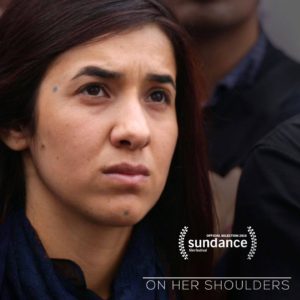
On Her Shoulders (Alexandria Bombach, 2018) [the paragraph, below, is an adaptation of a longer review I wrote for Hammer to Nail]
On Her Shoulders, the new documentary from Alexandria Bombach (co-director, Frame by Frame), opens with its 23-year-old heroine, Nadia Murad, pursued by an iPhone-wielding crowd of paparazzi or super-fans (or both). Is she some kind of pop-culture celebrity? She looks uncomfortable and upset, not at all relishing the attention, so maybe she is someone quite different. Indeed, she turns out to be a Yazidi survivor of the ISIS genocide against her people in northern Iraq. Abducted and sexually assaulted, she somehow escaped, and now travels the world as a goodwill ambassador on behalf of not only the Yazidi, but all victims of trafficking. It’s not a life she willingly chose – as she tells us, her dream was to run a hair salon – but it is a mission she accepts as inevitable and necessary. The film tracks her journey (which you can read about in her book, Last Girl) from reluctant emissary to powerful spokesperson, horrifying, moving and inspiring the viewer in equal measure. As social-advocacy documentaries go, this is a superlative example of the genre, giving us a fierce chronicle as specific as it is universal. In a world with a growing refugee crisis, we need more movies like this to remind us of the importance of human dignity, encouraging others to carry the burden of finding a solution on their shoulders, as well.
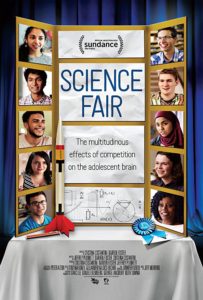
Science Fair (Cristina Costantini/Darren Foster, 2018) [the paragraph, below, is an adaptation of a longer review I wrote for Hammer to Nail, which has yet to post, as of this writing]
Winner of the first-ever “Festival Favorite Award” at the 2018 Sundance Film Festival, Science Fair – from directors Cristina Costantini and Darren Foster (both making their feature debut after working on various non-fiction TV series) – is an inspirational documentary about the hopeful future of our planet. We follow teens from around the world as they compete at the annual International Science and Engineering Fair (ISEF), each one bringing her/his unique project to be evaluated by a jury of specialists. They come from a wide array of backgrounds and countries – some quite poor, others more comfortable – and ethnicities. Some are entirely self-motivated, while others benefit from the strong mentorship of a dedicated teacher. All share one characteristic in common, however, which is their love of, and belief in, science. With a jaunty style that moves us quickly between scenes, the film has nary a dull moment. These kids are so engaging, as well, and their enthusiasm for what they do is so infectious, that it is hard not to weep with joy at the thought that the next generation has some capable scientists waiting in the wings, or even already active. A work of profound cinematic joy, Science Fair is a winner.
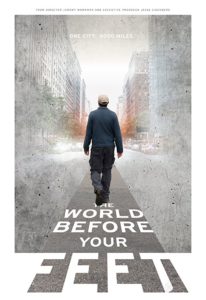
The World Before Your Feet (Jeremy Workman, 2018) [the paragraph, below, is an adaptation of a longer review I wrote for Hammer to Nail, which has yet to post, as of this writing]
Feet were made for walking, and former civil engineer Matt Green has a plan to use his to cover every block of New York City. Homeless by choice – it allows him to live on $15/day or less – Green stays in friends’ apartments, or cat-/dog-/house-sits at places he finds online, slowly chronicling his odyssey on a blog entitled I’m Just Walkin’. Sometimes he meets up with others with similar pedestrian goals, but mostly he walks alone, planning his itinerary based on where he has last spent the night. Filmmaker Jeremy Workman (Magical Universe) films Green’s daily routine with a variety of cameras, including the ubiquitous drones of today’s documentary world, which here help to show us needed context: New York in all its glorious geographic and demographic diversity. With over 8000 miles to conquer (6000 miles of city streets, and an additional 2000 or more of the parks, etc.), Green will not be done anytime soon, so perhaps the director can return for a sequel/update in a few years time, to see how his subject is faring. As friendly as he is, loneliness is an occupational hazard, and the former fiancée and former girlfriend Workman interviews, who wax not a little wistful at the good man trapped in an obsession, attest to opportunities for companionship gone by. Still, if he ever does complete his self-appointed task, Green will have a lifetime of stories to tell. Until then, he – and we – have this marvelous gem of a movie with which to pass the time.
That’s it for my favorites among the documentaries, although I also recommend ¡Las Sandanistas!, Agave: Spirit of a Nation, Garry Winogrand: All Things Are Photographable, Generation Wealth, Getting Over, The Gospel of Eureka and More Human Than Human
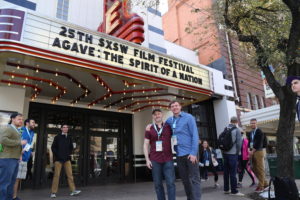
After five years, I can more than vouch for the fact that SXSW rocks. It’s a great festival to attend, although if you plan to go, it’s important to buy your film badge as soon as they go on sale (in August), as the price increases every month thereafter. Also, if you plan to book a hotel within reasonable distance of downtown Austin, you will need to do so through the official SXSW housing office, and you cannot book a room until you have a badge. Again, the earlier you take care of your travel details, the better. I plan to be back next year (when the fest will run March 8-17, 2019) and hope to see you there!

